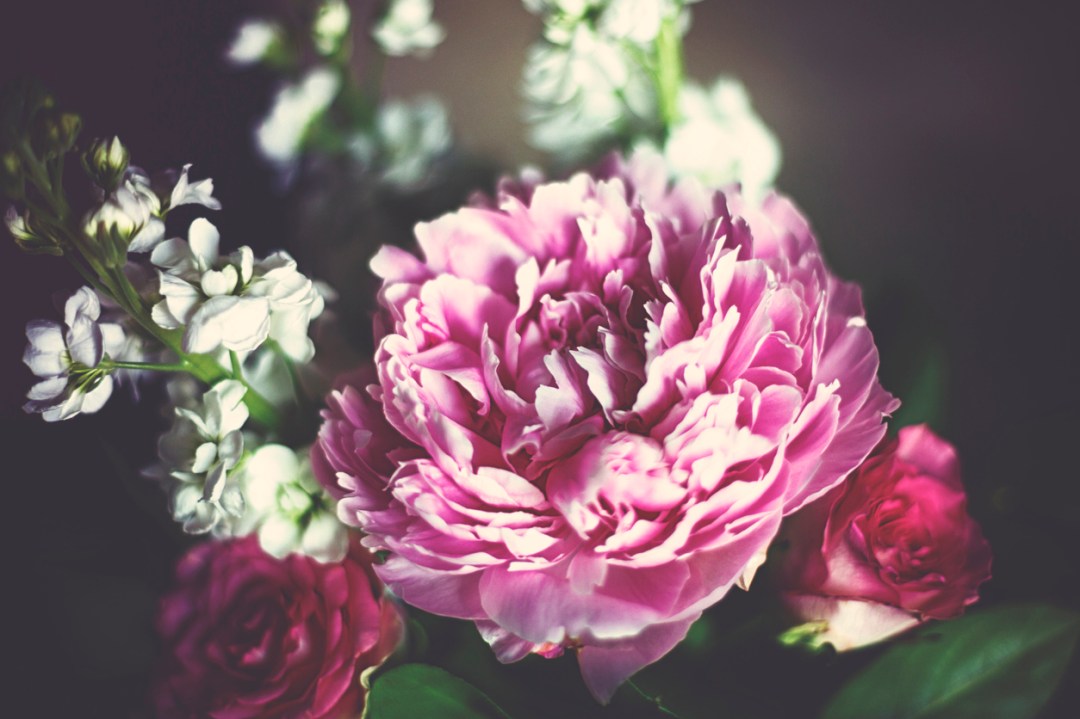It was a day typical of this year’s early summer. Raining. Cold. Miserable. I was about to crack and put the heating on when my sister arrived, carrying peonies. Over the coming hours, the rain rained harder, the cold got colder, and the peonies opened, becoming frothy balls of the palest powdery pink, touched by gold at the centre. Their unfurling seemed like an act of unbridled generosity.
The arrival of peonies is a wonderful thing. They sit in the supermarkets, clustered near the checkouts; their fat, rounded buds, hinting pinkly of what is to come when you take them home, introduce them to water and prepare to be surprised. Tuesday at Sainsbury’s might deliver the massive Barbara Cartland boudoir version, while Wednesday at Tesco’s brings a paler, more feathery, young Oscar Wilde, reclining on the chaise longue.
White, with the slightest pink blush, it’s a tribute to the favoured concubine of the Tang Dynasty Emperor Xuanzong
And you can’t be sure whether the peonies are going to be whoppers, practically the size of hats, or more modest flushed meringues, going for delicacy over razzmatazz. I’m talking about the pinks, obviously. The reds are something else, everything from Dietrich to Dracula, while the whites unfold into snow queens.
There’s quite a history of peonies in art. Edouard Manet grew them in his garden at Gennevilliers and painted them often. His ‘branch of white peonies and secateurs’ has two peonies flopping upon a dark table, full and heavy, but of silky softness – these are young beauties, virginal yet pregnant. Whole but fragile. You’d worry about picking them up in case they fell apart in your hands. Later, he painted a dozen full blooms in a rotund grey vase. Some are swirls of white with elements of gold to catch the light, others a blueish-pink, slightly sombre in tone, the brushwork so loose and sensuous they seem almost transparent.
Claude Monet entered his peony phase in 1882. One painting has a vase crammed with pinks, reds and whites; petals fallen all around on a table, scattered like confetti. Unlike Manet’s cool seductresses, these are celebratory peonies. Party peonies, as effervescent as champagne.
A century on, Cy Twombly fell for peonies. They are among the Polaroids he took in Italy of flowers and foods and ceramics, and converted into his ‘colour dry prints.’ Here the peonies become somehow ancient, painterly and Roman; they capture light and have a Caravaggian quality. In late 2006, he made his immense 18-foot-long peony blossom paintings. In one, the peony blooms are irregular floating clouds of white on green, green paint dripping from each, so that the flowers seem to be flourishing and weakening at the same time. It’s the same in real life – the moment of perfection of peonies is fleeting; they soon fade, albeit with supreme gentleness. On one of these works, Twombly inscribes a Haiku by the 17th century poet Takakai Kikaku:
Ah! The peonies
For which
Kusonoki
Took off his armour
A vision of a warrior, pausing for a moment to contemplate the wonder of peonies. I’m reminded of Dennis Potter, the dramatist, in his final days, facing death, and seeing nature with different eyes, when ‘the nowness of everything’ became ‘absolutely wondrous.’ Blossoms became ‘the frothiest, blossomest blossom there ever could be.’ He was talking of plum blossom – but I can’t see peonies now without this quote coming to mind.
The namers of peony varieties have nailed the brief. There’s one (little known) called ‘Yang Guifei steps out of the bath.’ White, with the slightest pink blush, it’s a tribute to the favoured concubine of the Tang Dynasty Emperor Xuanzong – this peony a tribute both to her beauty, and to the fact that the peony has been celebrated in China for a thousand years. It appears often in ancient Chinese scrolls, a symbol of love and wealth and status, and is to be found in the stonework and artwork of the Forbidden City in Beijing.
A friend has Shirley Temple performing in her garden, all sparkly and bouncy. In mine I have, I think, Sarah Bernhardt. She hogs the stage with her big, dramatic pure-pink puffballs. It’s easy to be over-the-top about them. Peonies are, after all, that way about themselves. Often extravagant and sumptuous; always elegiac – deigning to visit us for a few splendiferous weeks. Then, quite suddenly, they’re gone, and the peony season is over.








Comments